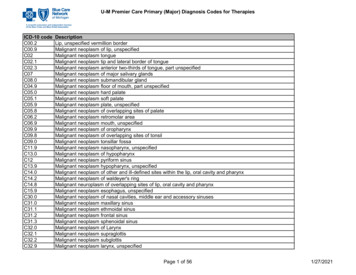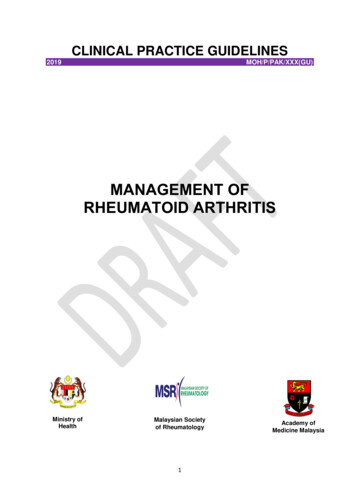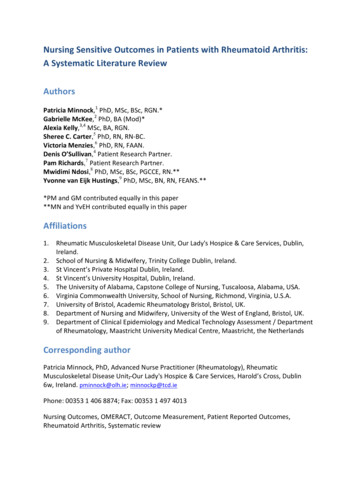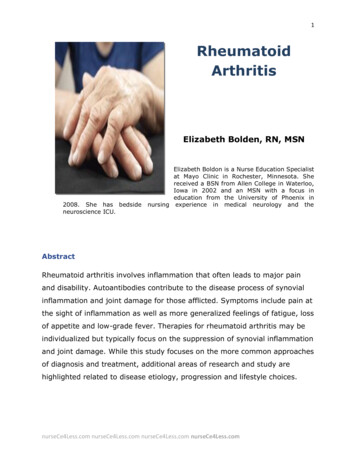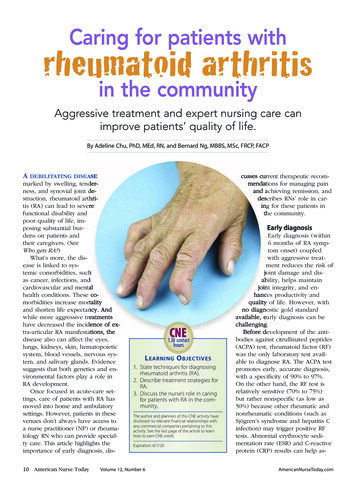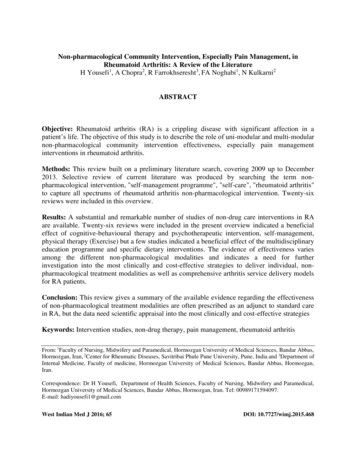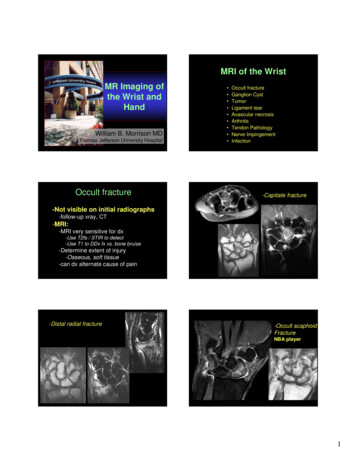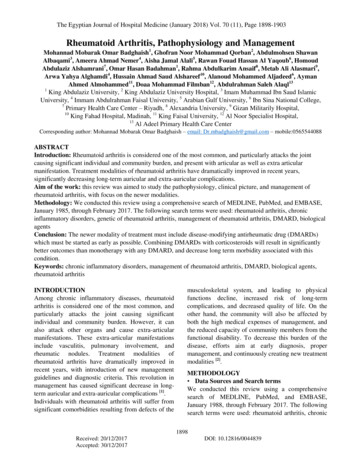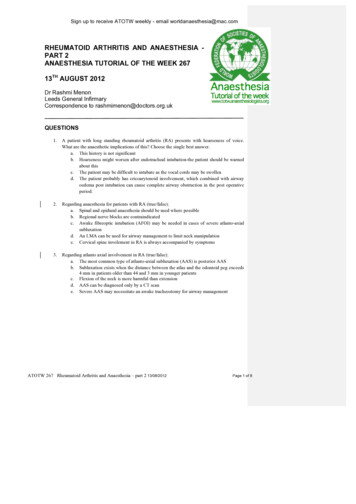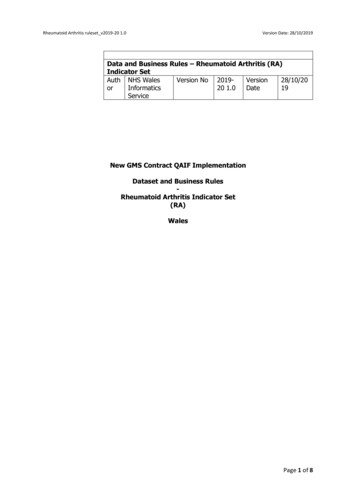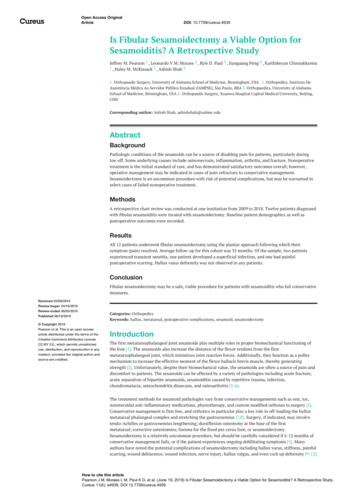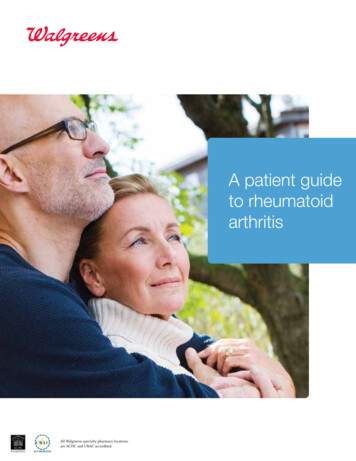
Transcription
A patient guideto rheumatoidarthritisURACAll Walgreens specialty pharmacy locationsare ACHC and URAC accredited.
Table of contentsUnderstanding rheumatoid arthritis (RA) 1How RA affects joints 1Who develops RA? 2Causes of RA 2Diagnosing RA 3RA by the numbers 3Coping with RA symptoms 4Living with RA 5Lifestyle changes 5RA and pregnancy 8Medication therapies 9Protecting your bones 9Surgery 10Ongoing care 10To learn more 11Sources 11Resources 13This publication should be used for general educational purposes only and is not intended to be a substitute for professional medical advice. Although it is intended to beaccurate, neither Walgreen Co., its subsidiaries or affiliates, nor any other party assumes liability for loss or damage due to reliance on this material. Advances in medicine maycause this information to become outdated, invalid or subject to debate. This information is not intended to create any warranty, and ALL SUCH WARRANTIES, EXPRESS ORIMPLIED, INCLUDING ANY WARRANTY OF FITNESS FOR A PARTICULAR PURPOSE, ARE HEREBY DISCLAIMED. If you are in need of immediate medical attention orhave a medical question, contact your medical professional.Inclusion of resources in this document does not imply endorsement by Walgreen Co. or any of its subsidiaries. These resources should be used for general information andeducational purposes only.Brand names are the property of their respective owners.
Understanding rheumatoid arthritis (RA)Understanding your diagnosis of rheumatoid arthritis,or RA, can help you take control of your health.Although there is no cure for RA, the number oftreatment options has increased over the last 10 years.Newer, more targeted therapies can minimize painand help you stay active. Beginning treatment soonafter your diagnosis can help prevent long-termdamage to your joints and your overall health.This booklet will provide you with information aboutRA, what to expect after your diagnosis and how tomanage symptoms to live a full and active life.Figure 1: How RA affects joint structureNormal jointCartilageMuscleEach joint in the body is a location where the ends oftwo bones meet. The ends of the bones are connectedtogether with a flexible coating called cartilage,as shown in Figure 1. Each joint is surroundedby synovium, a type of tissue that lubricates andnourishes the joint. In RA, this tissue becomesswollen and thick. This damages the cartilage andbone, weakens the tendons and nearby muscles,and makes it difficult to move. In some cases, severeswelling can cause the joints to become crookedand deformed.RA can affect many joints, including the hands, feet,wrists, elbows, shoulders, neck, hips and knees.As shown in Table 1 on page 2, RA differs fromosteoarthritis in several ways. RA usually affects thesmall joints in the hands and feet. In some people, theinflammation in RA might also affect other parts ofthe body, including the eyes, heart, lungs and kidneys.BoneBoneSinoviumHow RA affects jointsRA is a progressive, long-term condition that causesinflammation, or swelling, in the body’s joints. Theresulting pain and stiffness can make it difficult tomove around or complete everyday tasks.TendonSinovial fluidJoint capsuleJoint affected by rheumatoid arthritisBone loss/erosionCartilage lossBone loss(Generalized)Inflamed synoviumSwollen joint capsuleSource: Handout on health: rheumatoid arthritis.National Institute of Arthritisand Musculoskeletal and Skin Diseases Web site. . Accessed July 10, 2010.1
Understanding rheumatoid arthritis (continued)Table 1: Comparing rheumatoid arthritis and osteoarthritisCharacteristicRheumatoid arthritisOsteoarthritisAge at diagnosisBetween 30 and 5055 or olderDevelopment ofconditionDevelops quickly over weeks to monthsDevelops slowly over yearsMost commonlyaffected jointsSmall joints in the wrist, fingers, knuckles,ankles, feet and elbowsHips, knees, fingers and shouldersCommon symptoms Morning pain and stiffness that lastslonger than 30 minutes Stiffness and swelling that affectsjoints equally on both sides of thebody (symmetric) Tiredness and fever Stiffness after activity, at bedtime or in themorning that goes away after 30 minutes Affected joints not always on both sidesof the body (asymmetric) Swelling usually only in affected kneesWho develops RA?Although it is not clear what causes RA, certain riskfactors can make a person more likely to developthe disease: Environment. Some people who have inheritedthe likelihood of developing RA may not developthe disease until something in the environment,like bacteria or a virus, triggers the disease process. Age. Although the disease often begins in middleage and occurs with increased frequency in olderpeople, children and young adults also develop it. Lifestyle. Heavy smoking might increase the risk ofdeveloping RA, even in people who do not carry thegenes that lead to RA. Gender. Hormones might play a part in whodevelops RA. About 75 percent of those with RA arewomen, though the reason is unknown. Genes. There is some indication that RA ishereditary, or passed down through your family.If one or both of your parents were diagnosed withRA, you might have inherited certain genes thatmade you more likely to develop RA. However,many people can inherit and carry the geneswithout developing the disease.2Causes of RAUnlike osteoarthritis, RA is not caused by “wear andtear” on the joints. RA is an autoimmune disease. Thismeans it occurs because the body’s immune system isnot working properly. Your immune system serves asyour body’s guard against illness. It is designed to seekout and attack any intruding bacteria or viruses thatcould make you sick. It also helps your body recoverand heal after an injury.
When your immune system is not working properly,it cannot tell the difference between harmful intrudercells and good cells from your own body. Because ofthis, the immune system attacks your body’s healthycells by mistake.In a person with RA, the immune system mistakenlyattacks the healthy tissue surrounding the joints. Atthe same time, the body calls up too many cells tofight off the attack. The result is pain and swelling.Doctors are not completely sure what causesautoimmune diseases, but some research suggeststhat they result from changes in the immune system.Hormones might also play a role, because women aremore likely to develop autoimmune diseases like RA.Because RA can change the immune system, thosewith RA also might face a slightly increased risk ofcertain types of cancers, including lymphoma andblood cancers.RA by the numbersDiagnosing RA1.3 millionAdults in the United States living with RARA can be difficult to diagnose because its symptomsare similar to other types of joint disease. Also, manyRA symptoms take some time to develop.There is no single test to diagnose RA. When you werediagnosed, your doctor likely used several kinds ofinformation: Your description of symptoms, such as joint pain orswelling A physical examination of your joints, skin, reflexesand muscle strength70% of RA patients are women30-50 years oldAge of onset for RA is 30-50 years of ageSource: Arthritis related statistics. Arthritis Foundation Website. eid 31&df definition. Accessed July 13, 2010.There are three common findings in blood tests ofthose with RA: Anemia, or a low red blood cell count X-rays, which can show joint damage in advancedcases of RA Presence of rheumatoid factor, an antibody foundin about 80 percent of those with RA Blood tests, which can identify problems in theimmune system An elevated erythrocyte sedimentation rate or “sedrate,” which is linked to the level of inflammationin the joints3
Understanding rheumatoid arthritis (continued)Other symptoms can include: Pain and stiffness in the joints for more than30 minutes after awakening in the morning or aftera long rest Mild fever Fatigue or tiredness Lumps called nodules under the skin at pressurepoints, like the elbows Dry eyes and mouth Numbness or tingling Loss of appetitePeople with RA seem to be more likely to developperiodontal disease, a chronic bacterial infection ofthe gums that can lead to tooth loss. About2 percent to 5 percent of people with RA alsodevelop rheumatoid vasculitis, a condition that causesswelling in the blood vessels that can affect the skinand other organs, including the heart and lungs.Those with RA may also develop Sjogren’s syndrome,an autoimmune disease that causes dryness in themouth, eyes and other parts of the body.Coping with RA symptomsRA is characterized by inflammation of the joints thatmakes normal movement difficult or uncomfortable.Pain, stiffness, swelling, redness and warmth in thejoints are common symptoms. The symptoms typicallyappear first in the wrists and fingers, then in theelbows, ankles, feet and toes before moving to otherjoints in the body. Symptoms are usually symmetric,appearing equally on both sides of the body.4RA symptoms often cycle between flares andremissions. Flares are episodes when symptomsbecome worse. During remissions, there may be fewersymptoms or none at all. Nearly half of all peopleliving with RA may be able to achieve remission, inpart, because of improved treatment options andthe availability of targeted treatment immediatelyafter diagnosis.
Living with RAAlthough there is no cure for RA, there are manyways you can manage the symptoms and minimizedamage to your joints. It is important that you workwith your doctor to find the approach that is best foryou. A rheumatologist, or doctor who specializes intreating arthritis and other bone and joint diseases,can offer guidance.It is important to balance exercise with rest, especiallywhen you are experiencing a flare. Your doctor orphysical therapist can talk to you about how longyou should take a break from exercise when you areexperiencing a flare. You might also want to use asplint, brace or other support item that can helpstabilize your joints during exercise or even duringdaily activities.The main goals of RA therapy are: Reducing swelling and pain in the joints Preserving movement Slowing the progression of the disease Minimizing or preventing permanent damageto the jointsLifestyle changes and medication help most peoplewith RA achieve these goals. In some cases, surgerymay be recommended.Lifestyle changesPhysical activity, changing the way you approacheveryday tasks, eating right and managing stress canhelp you feel better each day.Physical activityRegular, gentle exercise will help keep your jointsflexible and the rest of your body healthy. It also canhelp you maintain a healthy weight to minimize anyextra stress on your joints. Talk to your doctor or yourphysical therapist about doing three types of exercise: Stretching and range-of-motion, like gentle yogaor tai chi Strengthening, such as weight training Cardiovascular, or aerobic, including walkingor swimming5
Living with RA (continued)Everyday tasksAt work:Pain and swelling in your joints might make it hardto complete daily tasks at home or work. You canmake small modifications to help make your everydayroutines safer and easier. Arrange your desk or workspace so you cancomplete tasks with the least amount ofphysical strain.At home: Arrange items in your cupboards and cabinets soitems that you use most often are at the front of thelowest shelves. Try to replace heavy appliances, like vacuumcleaners, with lighter models. Tie string or strips of cloth to the handles ofcabinets and drawers to make them easier to open. Replace doorknobs with levers that you can pushdown to open. Make sure area rugs are fixed to the floor withadhesive or fabric fasteners so they do notslide around. Take breaks from repetitive motion as often asyou can. Tackle your most important tasks at the time of daywhen you feel most energetic.Managing flaresIt is not clear what triggers flares, but for somepeople, the episodes may be brought on by stressor infection. When flares occur, there are steps youcan take to manage the pain and continue yourdaily activities: Apply a hot or cold pack to swollen joints.– Use heat to relieve pain and relax your muscles.– Use cold for occasional flares to dull thesensation of pain and decrease muscle spasms.– Do not use either if you have poor circulationor numbness. Use relaxation and other mental techniques to keepyour mind off the symptoms. Balance daily activities and exercise with periodsof rest. Get help from others.– Don’t be afraid to ask for help from family,friends or co-workers.– Build a support group. Create a back-up plan. Talk to your family and coworkers about how they can help if you experiencea flare and are unable to complete everyday tasks.Talk to your doctor about what you should do in caseof a flare, and create a plan that is easy to follow.6
Healthy eatingIt is important to follow a healthy, balanced dietthat includes: Whole grains, like oatmeal or brown rice Fruits and vegetables Low or no saturated fat, especially animal fat Low amounts of salt and sugar The daily recommended amount of vitaminsand mineralsResearch has also suggested that eating foods richin omega-3 fatty acids, such as fish, can help reduceinflammation in your body.If you drink alcohol, do so in moderation. If younotice certain foods seem to increase the swelling inyour joints, try to avoid them.Maintaining emotional healthYou can also improve your physical health byimproving your emotional health. High levels of stressmight increase your tendency to experience flaresand might make it more difficult to deal with thechallenges of living with RA.You can take steps to understand and controlyour stress: Spend some time to identify what stresses you bykeeping a journal or diary. Try to avoid things that contribute to your stress. Develop positive ways to cope, like making timefor hobbies you enjoy or simply relaxing in a quietspace each day.Sometimes, you might find yourself feeling frustratedor sad about some of the challenges you face whenliving with RA. Tasks that used to be simple mightnow be difficult or might require the help of others.Some days, pain and fatigue might leave you feelinghelpless or overwhelmed. It’s normal to feel this way,especially at first. It can help to seek support fromfriends and family or take extra time to do things thatmake you happy. You might want to find a supportgroup or online message board for people with RA.7
Living with RA (continued)It’s also important to know that symptoms ofdepression may include some or all of the following: Feeling sad, empty or anxious most of the time Losing interest or pleasure in activities that youpreviously enjoyed Being tired or lacking energy Feeling restless or irritable Eating too much or too little Having difficulty concentrating or making decisions Feeling worthless, helpless or guilty Sleeping too much or too little Thinking about death or suicideIf you have thoughts of suicide, you should call 911or your local emergency services number. If youdon’t want to do that, contact a doctor, mental healthprofessional, crisis center or hotline.If you think you may be depressed, talk with yourdoctor. Your doctor may recommend counseling (alsocalled psychotherapy), antidepressant medications ora combination of both. Counseling involves talkingwith a mental health professional, or therapist, aboutyour thoughts and feelings.Antidepressant medications help correct imbalancesin brain chemicals. It can take several monthsbefore you start experiencing the full benefits ofantidepressants. However, you may notice sideeffects sooner. Side effects of antidepressants mayinclude headache, nausea, diarrhea, constipationand lack of sex drive. Talk with your doctor if yourdepression does not improve. Your medication dosemay need to be adjusted or you might need to try adifferent antidepressant.8RA and pregnancyResearch suggests that RA symptoms improveduring pregnancy, but symptoms usually returnand flares can occur after the baby is born. Ifyou have been diagnosed with RA and you arepregnant or plan to be pregnant soon, talk toyour doctor about your medications. Some RAmedications are not considered safe duringpregnancy, and you may temporarily have tostop taking them. Some medications can alsoaffect fertility in both men and women. Askyour doctor which medications are safe to takewhen breastfeeding.
Protecting your bonesTogether with your doctor, you will want totrack the health of your bones. You may wantto ask your doctor whether you should takea bone density test. Many people with RAdevelop osteoporosis, a condition in whichthe bones become brittle and easy to break.This is especially true if you take large doses ofcorticosteroids, such as prednisone, over a longperiod of time.There are several steps you can take to helpprevent osteoporosis: Get enough calcium and vitamin D inyour diet. Do gentle, weight-bearing exercise, likewalking, as recommended by your doctor.Medication therapies Do not smoke.Medication therapies, along with lifestyle changes,can help keep you moving with less pain. Not alltreatments work for everyone, so it is important thatyou talk with your doctor about what works best foryou now and as your needs change with time. Drink alcohol only in moderation.There are several types of medications prescribed totreat RA: Nonsteroidal anti-inflammatory drugs, which helprelieve swelling in the joints Corticosteroids, which also help relieve swelling inthe joints Disease-modifying antirheumatic drugs, whichsuppress the immune system to slow down thedisease process Biologic response modifiers, which target parts ofthe immune system that cause the joints to swellMore information about medication therapies forRA is provided in the booklet, Understanding yourrheumatoid arthritis medications.9
Living with RA (continued)SurgeryOngoing careIf your RA does not improve with medicationtherapy and lifestyle changes, or if RA has made itextremely painful, difficult or impossible to movecertain joints, your doctor might suggest surgery as atreatment option.You should continue to see your doctor regularlyto determine how well your medication is workingand whether your treatment should be adjusted. Tomonitor your progress, your doctor will likely performblood tests and other lab tests. Your doctor will alsomonitor any side effects you might experience fromRA medication and adjust your treatment as needed.There are several surgical procedures that may beused to treat RA: Arthroscopic surgery is done using a thin, lightedtube that allows the doctor to see inside your jointto remove loose cartilage, smooth joint surfaces orremove swollen tissue. Tendon reconstruction is used to repair andreconstruct tendons (most often in the hands) thathave been damaged by RA. A synovectomy removes inflamed tissue aroundyour joints.– This provides only temporary relief, as the tissuewill eventually grow back.– This surgery is usually done as a part ofreconstructive surgery. Joint fusion surgery connects the ends of two bonesin a joint. This can limit movement but can relievepain and increase stability. Joint replacement surgery removes an arthriticjoint and replaces it with a new, artificial joint.10
To learn moreThe more informed you are, the better you canmanage your health. Our specialty pharmacyCare Team provides personalized, supportive anddependable care to help you achieve the best resultsfrom your prescribed therapy.Arthritis related statistics. National Center forChronic Disease Prevention and Health Promotion.Centers for Disease Control and Prevention Website. ed July 10, 2010.SourcesExercise and arthritis: three types of exercise you needto do. Arthritis Foundation Web site. www.arthritis.org/types-exercise.php. Accessed July 10, 2010.The following sources were used in the developmentof this booklet and the companion piece,Understanding your rheumatoid arthritis medications.Arthritis Foundation Disease Center: Overview:What is it?. Arthritis Foundation Web d 31&df definition. Accessed July 10, 2010.Arthritis Foundation Disease Center: Overview:What causes it? Arthritis Foundation Web d 31&df causes. Accessed July 10, 2010.Arthritis Foundation Disease Center: Overview:What are the effects? Arthritis Foundation Website. www.arthritis.org/disease-center.php?diseaseid 31&df effects. Accessed July 10, 2010.Arthritis Foundation Disease Center: Overview:How is it diagnosed? Arthritis Foundation Website. www.arthritis.org/disease-center.php?diseaseid 31&df diagnosed. Accessed July 10, 2010.Arthritis Foundation Disease Center: Overview:Treatment options. Arthritis Foundation Web d 31&df treatments. Accessed July 10, 2010.Arthritis Foundation Disease Center: Overview:Who is at risk? Arthritis Foundation Web d 31&df whos at risk. Accessed July 10, 2010.Arthritis Foundation Disease Center: Overview:Resources & We also suggest. Arthritis FoundationWeb site. www.arthritis.org/disease-center.php?disease id 31&df resources. AccessedJuly 10, 2010.Handout on health: osteoarthritis. NationalInstitute of Arthritis and Musculoskeletal and SkinDiseases Web site. www.niams.nih.gov/Health Info/Osteoarthritis/default.asp. Accessed July 10, 2010.Handout on health: rheumatoid arthritis. NationalInstitute of Arthritis and Musculoskeletal andSkin Diseases Web site. www.niams.nih.gov/HealthInfo/Rheumatic Disease/default.asp. AccessedJuly 10, 2010.The immune system and your arthritis: understandthe immune system’s role in your disease [patientbrochure]. Arthritis Foundation, Atlanta, GA; 2006.Osteoporosis and arthritis: two common but differentconditions. National Institute of Arthritis andMusculoskeletal and Skin Diseases Web site.www.niams.nih.gov/Health Info/Bone/Osteoporosis/Conditions Behaviors/osteoporosis arthritis.asp.Accessed July 10, 2010.Rheumatoid arthritis. American College ofRheumatology Web site. dex.asp. AccessedJuly 10, 2010.Johns Hopkins Arthritis Center. Johns HopkinsHospital Web site. d-arthritis/index.html.Accessed July 20, 2010.Rheumatoid arthritis: percentage of patientswith an established diagnosis of sero-positiverheumatoid arthritis (RA), or RA and synovitis or11
To learn more (continued)RA and radiographic erosions who are treated witha disease-modifying antirheumatic drug (DMARD)unless contraindication to DMARD is documented.National Quality Measures Clearinghouse Web aspx?ss 1&doc id 8075. Accessed July 10, 2010.Rheumatoid arthritis: Lifestyle and home remedies.Mayo Clinic Web site. 0020/DSECTION lifestyl and-hom-remedies. Accessed July 10, 2010.Richards L. Fatty Acid Benefits: How Omega-3sReduce Inflammation. Arthritis Today. ArthritisFoundation Web site. ealth-eating/food-and inflammation/fatty-acids-benefits.php. AccessedJuly 10, 2010.Drug Guide. Arthritis Foundation Web site. .php.Accessed July 12, 2010.Yeap SS, Hosking DJ. Management of corticosteroidinduced osteoporosis. Rheumatology (Oxford).2002;41(10):1088–1094.ResourcesAmerican College of Rheumatologywww.rheumatology.org404-633-3777The ACR is an international organization thatsupports ongoing education, research and advocacyabout rheumatic diseases, including rheumatoidarthritis. The web site features a searchable directoryof rheumatologists.Sheehy C, Murphy E, Barry M. Editorial: depressionin rheumatoid arthritis—underscoring the problem.Rheumatology (Oxford). 2006;45(11):1325–1327.Arthritis FoundationSymmons DPM. Editorial: lymphoma and rheumatoidarthritis–again. Rheumatology (Oxford). 2007;46(1):1–2.The Arthritis Foundation is the only national notfor-profit organization that supports the more than100 types of arthritis and related conditions withadvocacy, programs, services and research.Twin study reveals three genes involved inrheumatoid arthritis. National Institute of Arthritisand Musculoskeletal and Skin Diseases Web site.www.niams.nih.gov/News and events/Spotlighton research/2006/three genes ra.asp. AccessedJuly 10, 2010.What is rheumatoid arthritis? National Institute ofArthritis and Musculoskeletal and Skin Diseases Website. www.niams.nih.gov/Health Info/RheumaticDisease/rheumatoid arthritis ff.asp. AccessedJuly 10, 2010.The NIH Osteoporosis and Related Bone DiseasesNational Resource Center. What people withrheumatoid arthritis need to know about osteoporosis.National Institute of Arthritis and Musculoskeletaland Skin Diseases Web site. www.niams.nih.gov/Health Info/Bone/default.asp. Accessed July 10, 2010.12www.arthritis.org800-283-7800National Institute of Arthritis and Musculoskeletaland Skin Diseaseswww.niams.nih.gov877-22-NIAMS (64267)Part of the National Institutes of Health, the NationalInstitute of Arthritis and Musculoskeletal and SkinDiseases supports research on arthritis and othermusculoskeletal and skin diseases. A registry ofresearch studies on rheumatoid arthritis is availableon the website.
ResourcesAmerican College of Rheumatologywww.rheumatology.org404-633-3777The ACR is an international organization thatsupports ongoing education, research and advocacyabout rheumatic diseases, including rheumatoidarthritis. The website features a searchable directoryof rheumatologists.Arthritis Foundationwww.arthritis.org800-283-7800The Arthritis Foundation is the only national notfor-profit organization that supports the more than100 types of arthritis and related conditions withadvocacy, programs, services and research.National Institute of Arthritis and Musculoskeletaland Skin Diseaseswww.niams.nih.gov877-22-NIAMS (64267)Part of the National Institutes of Health, the NationalInstitute of Arthritis and Musculoskeletal and SkinDiseases supports research on arthritis and othermusculoskeletal and skin diseases. A registry ofresearch studies on rheumatoid arthritis is availableon the website.13
w There's a way 2010 Walgreen Co. All rights reserved.11SP0179-1211
Understanding your diagnosis of rheumatoid arthritis, Understanding rheumatoid arthritis (RA) or RA, can help you take control of your health. Although there is no cure for RA, the number of treatment options has increased over the last 10 years. Newer, more targeted therapies can minimize pain and help you stay active. Beginning treatment soon
